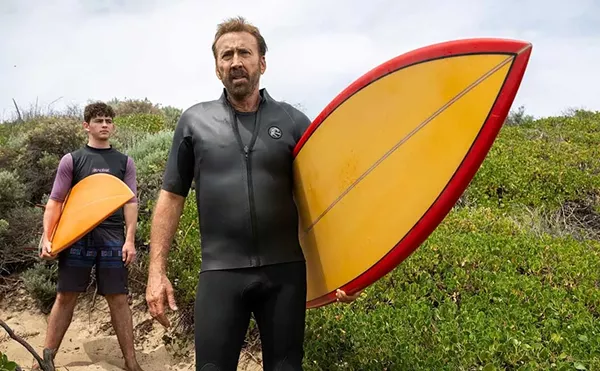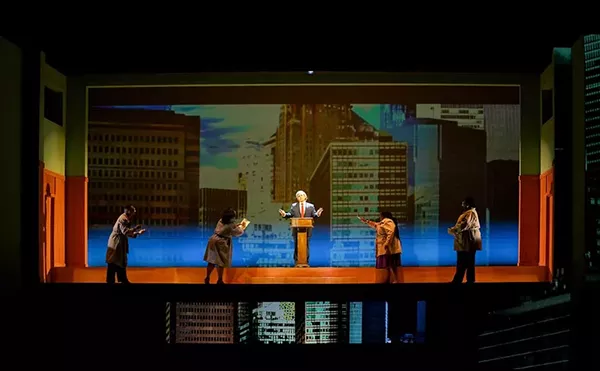
Audio By Carbonatix
[
{
"name": "GPT - Leaderboard - Inline - Content",
"component": "35519556",
"insertPoint": "5th",
"startingPoint": "3",
"requiredCountToDisplay": "3",
"maxInsertions": 100,
"adList": [
{
"adPreset": "LeaderboardInline"
}
]
}
]
Tony Conrad was there, in New York, in the early 1960s, for the birth of the cool. A bespectacled kid fresh out of Harvard (where he majored in math, not music, as is commonly assumed), he fell in with a crowd of downtown hipsters who believed that one sustained note was better than the two, three or four it normally took to build melody or conventional song structure. Conrad and his fellow composers and improvisers in this "Dream Syndicate" began calling what they did "eternal music," because it had no beginning or end, only a blistering, shimmering middle that could drone on for hours.
The ensemble featured La Monte Young, Marian Zazeela, John Cale, Angus MacLise and Conrad, who performed amplified violin on "Day of Niagara," a menacing 30-minute piece from 1965 that remains — despite a reported more than 100 hours of tapes still locked in Young's archive — the group's only official release.
Conrad stayed busy in the early days of minimalism, joining Cale and Lou Reed (and notable sculptor-to-be Walter De Maria) in a band called the Primitives. It was Conrad's copy of The Velvet Underground, an early erotic novel filled with sleazy reportage on the S&M scene, that provided the name for Reed and Cale's (and MacLise's, for a time) new band. But that's a tangent for another story.
He also began doing experimental video work, and is often cited as one of the pioneers of the Structural Film movement. His 1966 film, The Flicker, a stark black and white piece consisting of only five frames, got much attention for literally making several members of the audience sick during its initial screening (it began with a warning cautioning viewers to remain in the theater at their own risk, and encouraged physicians to be in attendance). In 1999, the film was included in a wide-ranging exhibition called The American Century at New York's Whitney Museum of American Art.
Conrad lived in Manhattan and made films there until the early 1970s, when two key developments took place: He was invited to Germany to record in a farmhouse studio owned by the Krautrock group Faust; and he took a teaching position at Antioch College in Ohio, beginning what has become three full decades of teaching students how to make art out of, well, nothing.
Chasing down Tony Conrad in the present proves to be nearly as easy as tracing his well-documented past. He's performing in Europe, but promptly replies to an e-mail, saying he will be back stateside the following week. A phone call from Detroit upon his return finds him in a car in Brooklyn, outside his studio and gallery space in Williamsburg. Though he confesses, "my approaches have always been minimal," this rule apparently does not apply to Conrad in conversation. He talks for more than an hour about his career in the fast lane of the American avant-garde, and does so plainly, politely and without interruption, despite greeting a visitor to his studio while continuing the long distance interview. He sounds most pleased when asked about his influence on current trends in pop and electronic music, which contain many of the ideas Conrad and his peers began fertilizing 45 years ago.
"I am thrilled that younger composers have turned to noise, that we're seeing artists making all kinds of diverse music on laptops," he says. "There are lots of echoes in this for me. I couldn't be more happy about it."
There are indeed echoes of his work everywhere, from his early inspiration for the Velvet Underground to artists like Suicide, Jesus And Mary Chain, Spacemen 3, Sonic Youth, Rhys Chatham and countless others who've used texture and tone above all else to make their music.
"I've always believed music based on one note, like Indian music, like African drumming, the most simple kinds of music, can also be the most expressive and compelling," he says.
It was those sessions with Faust — which were released in the UK in 1973 but then given a second life on the indie label Table of the Elements in this country 20 years later — that helped fuel Chicago's arty post-rock scene led by bands like Tortoise and Gastr Del Sol (Conrad played violin on the band's Upgrade & Afterlife LP) in the early to mid-1990s. Then in his early 50s, he suddenly found himself in hot demand by the coolest kids on the planet.
By that time, Conrad had moved to upstate New York, where he took a position teaching video and film at SUNY-Buffalo's Department of Media Study. Now 67, he remains on the faculty at the university, although he's currently on sabbatical.
He's still juggling various projects, traveling to Europe and Australia, where he's recently performed and screened his film works in museums and art galleries. But he still remains committed to his students.
"Teaching meshes nicely with everything I do," Conrad says. "I give myself the time to do a variety of creative things. I've resisted making a career out of just one thread. I think you have to challenge the contemporary edge, in sound and visual art, tear things down and explore what's left."
He'll soon take to the road again. He's playing in Berlin, Copenhagen and Riga, Latvia, before making his first-ever live appearance in Detroit this Friday at MOCAD. Conrad is performing with M.V. Carbon, a Brooklyn-based sound/visual artist who's a member of the group Metalux. The show also includes Dearborn space-rock duo Windy & Carl, and Michigan noise titans Wolf Eyes. The following night, Conrad will offer a retrospective of his films. Afterward, the audience can join in on a discussion of his work.
The film program will be a mix of older and newer work, Conrad says, which contrast in style.
"It will be a survey of the sorts of things I've produced over a long career. The early work is quite austere, hypnotic, hallucinatory," he says. "The later work includes more social content and is meant to interact with the viewers. I think some [of the films] should be rather unexpected and amusing."
Although he's never performed here, Conrad is intimately connected to Detroit. His late first wife, Beverly Grant Conrad — who acted in Andy Warhol's film 13 Most Beautiful Women and co-produced the Conrad's 1970 short Straight and Narrow — was a native of the city.
"We used to come here to visit family," he says. "I loved it because it was a working town, with music deeply rooted in real human needs and feelings. I am drawn to music with soul, passion and a hard-driving power. That's what Detroit has in abundance."
The artist says he plans to make his weekend here memorable.
"I hope people come with an expectation that they are going to hear and see something quite different," he says. "The music and film will hark back to moments from the early 1960s, at the beginnings of the ambient and minimal movements. But we will push the limits of the possible and make it a high-octane experience in the present. Tesla coil sparks will fly, I can assure you."
Tony Conrad performs live with M.V. Carbon, Windy & Carl and Wolf Eyes on Friday, Dec. 7, at the Museum of Contemporary Art Detroit, 4454 Woodward Ave., Detroit. All ages. Doors 8 p.m. $16. On Saturday, Dec. 8, a program featuring Conrad's films followed by a discussion begins at 7 p.m. $9.





